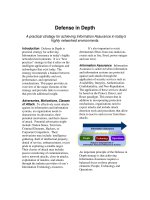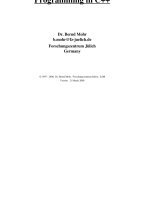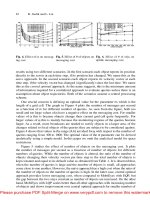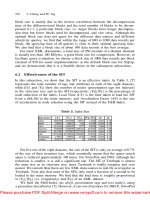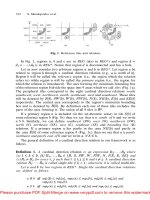Tài liệu DNS in Action docx
Bạn đang xem bản rút gọn của tài liệu. Xem và tải ngay bản đầy đủ của tài liệu tại đây (3.41 MB, 195 trang )
DNS in Action
A detailed and practical guide to DNS
implementation, configuration, and administration
Libor Dostálek
Alena Kabelová
BIRMINGHAM - MUMBAI
DNS in Action
A detailed and practical guide to DNS implementation, configuration,
and administration
Copyright © 2006 Packt Publishing
All rights reserved. No part of this book may be reproduced, stored in a retrieval system,
or transmitted in any form or by any means, without the prior written permission of the
publisher, except in the case of brief quotations embedded in critical articles or reviews.
Every effort has been made in the preparation of this book to ensure the accuracy of the
information presented. However, the information contained in this book is sold without
warranty, either express or implied. Neither the authors, Packt Publishing, nor its dealers
or distributors will be held liable for any damages caused or alleged to be caused directly
or indirectly by this book.
Packt Publishing has endeavored to provide trademark information about all the
companies and products mentioned in this book by the appropriate use of capitals.
However, Packt Publishing cannot guarantee the accuracy of this information.
First published: March 2006
Production Reference: 1240206
Published by Packt Publishing Ltd.
32 Lincoln Road
Olton
Birmingham, B27 6PA, UK.
ISBN 1-904811-78-7
www.packtpub.com
Cover Design by
www.visionwt.com
This is an authorized and updated translation from the Czech language.
Copyright © Computer Press 2003 Velký průvodce protokoly TCP/IP a systémem DNS.
ISBN: 80-722-6675-6. All rights reserved.
Credits
Authors
Libor Dostálek
Alena Kabelová
Technical Editors
Darshan Parekh
Abhishek Shirodkar
Editorial Manager
Dipali Chittar
Development Editor
Louay Fatoohi
Indexer
Abhishek Shirodkar
Proofreader
Chris Smith
Production Coordinator
Manjiri Nadkarni
Cover Designer
Helen Wood
About the Authors
Libor Dostálek was born in 1957 in Prague, Europe. He graduated in mathematics at the
Charles University in Prague. For the last 20 years he has been involved in ICT architecture
and security. His experiences as the IT architect and the hostmaster of one of the first
European Internet Service Providers have been used while writing this publication.
Later he became an IT architect of one of the first home banking applications fully based on
the PKI architecture, and also an IT architect of one of the first GSM banking applications
(mobile banking). As a head consultant, he designed the architecture of several European
public certification service providers (certification authorities) and also many e-commerce
and e-banking applications.
The public knows him either as an author of many publications about TCP/IP and security
or as a teacher. He has taught at various schools as well as held various commercial
courses. At present, he lectures on Cryptology at the Charles University in Prague.
He is currently an employee of the Siemens.
Alena Kabelová was born in 1964 in Budweis, Europe. She graduated in ICT at the
Economical University in Prague. She worked together with Libor Dostálek as a
hostmaster. She is mostly involved in software development and teaching. At present, she
works as a senior project manager at the PVT and focuses mainly on electronic banking.
Her experiences as the hostmaster of an important European ISP are applied in this publication.
Table of Contents
Preface 1
Chapter 1: Domain Name System 5
1.1 Domains and Subdomains 6
1.2 Name Syntax 7
1.3 Reverse Domains 8
1.4 Domain 0.0.127.in-addr.arpa 9
1.5 Zone 10
1.5.1 Special Zones 10
1.6 Reserved Domains and Pseudodomains 11
1.7 Queries (Translations) 11
1.7.1 Round Robin 15
1.8 Resolvers 16
1.8.1 Resolver Configuration in UNIX 16
1.8.2 Resolver Configuration in Windows 17
1.9 Name Server 20
1.10 Forwarder Servers 24
Chapter 2: DNS Protocol 27
2.1 Resource Records 27
2.2 DNS Protocol 29
2.3 DNS Query 29
2.3.1 DNS Query Packet Format 30
2.3.2 DNS Query Packet Header 30
2.3.3 Question Section 32
2.3.4 The Answer Section, Authoritative Servers, and Additional Information 34
2.3.5 Compression 36
2.3.6 Inverse Query 38
2.3.7 Methods of RR Transfer via a DNS Packet 38
2.3.8 Communication Examples 38
Table of Contents
Chapter 3: DNS Extension 47
3.1 DNS Update 47
3.1.1 Header Section 49
3.1.2 Zone Section 50
3.1.3 Prerequisite Section 50
3.1.4 Update Section 51
3.1.5 Additional Data Section 51
3.1.6 Journal File 52
3.1.7 Notes 52
3.2 DNS Notify 52
3.2.1 Notify Message 53
3.3 Incremental Zone Transfer 55
3.3.1 Request Format 55
3.3.2 Reply Format 56
3.3.3 Purging 56
3.3.4 Examples from RFC 1995 56
3.4 Negative Caching (DNS NCACHE) 58
3.4.1 How Long are Negative Answers Stored in Memory? 59
3.4.2 The MINIMUM Field in an SOA Record 60
3.4.3 Saving Negative Reply Rules 60
3.5 DNS IP version 6 Extension 60
3.5.1 AAAA Records 61
3.5.2 A6 Records 61
3.5.3 Reverse Domains 62
3.5.4 DNAME Records 63
3.6 DNS Security Protocols 64
3.6.1 DNSsec 64
3.6.2 KEY Record 65
3.6.3 SIG Record 67
3.6.4 NXT Record 71
3.6.5 Zone Signature 73
3.6.6 Display Data 74
3.6.7 DNS Protocol 75
3.7 TSIG 76
3.7.1 TKEY 77
3.8 Saving Certificates to DNS 78
ii
Table of Contents
Chapter 4: Name Server Implementation 79
4.1 DNS Database 79
4.2 RR Format 81
4.2.1 SOA Records 81
4.2.2 A Records 82
4.2.3 CNAME Records 83
4.2.4 HINFO and TXT Records 83
4.2.5 NS Records 84
4.2.6 MX Records 85
4.2.7 PTR Records 85
4.2.8 SRV Records 87
4.2.9 $ORIGIN 88
4.2.10 $INCLUDE 89
4.2.11 Asterisk (*) in a DNS Name 89
4.3 Name Server Implementation in BIND 89
4.3.1 named Program in BIND Version 4 System 90
4.3.2 New Generation BIND 91
4.3.2.1 Configuration File 93
4.3.2.2 DNS Database 109
4.3.2.3 Lightweight Resolver 110
4.4 Microsoft's Native Implementation of DNS in Windows 2000/2003 111
Chapter 5: Tools for DNS Debugging and Administration 117
5.1 Tools for DNS Debugging 117
5.1.1 Check Configuration Files 118
5.1.2 named-checkconf Utility 118
5.1.3 named-checkzone Utility 118
5.1.4 nslookup Program 118
5.1.4.1 Debugging Mode 121
5.1.4.2 Debug Debugging Level 121
5.1.4.3 d2 Debugging Level 123
5.1.5 Other Programs Used for Debugging DNS 126
5.1.5.1 The dnswalk Program 126
5.1.5.2 The dig Program 126
5.2 The rndc Program 128
5.2.1 Signals 129
5.2.1.1 HUP Signal 130
5.2.1.2 INT Signal 130
5.2.1.3 IOT Signal 132
iii
Table of Contents
5.2.1.4 TERM Signal 133
5.2.1.5 KILL Signal 133
5.2.1.6 USR1 and USR2 Signals 133
5.3 Errors in DNS Configuration 134
Chapter 6: Domain Delegation and Registration 135
6.1 Example 1 135
6.1.1 Server ns.company.tld 136
6.1.2 Server ns.provider.net 136
6.1.3 Server ns.manager-tld.tld 137
6.2 Example 2 137
6.2.1 Server ns.company.com 138
6.2.2 Server ns.branch.company.tld 138
6.3 Domain Registration 139
Chapter 7: Reverse Domain Delegation 143
Chapter 8: Internet Registry 149
8.1 International Organizations 149
8.2 Regional Internet Registry (RIR) 151
8.3 IP Addresses and AS Numbers 152
8.4 Internet Registry 154
8.4.1 Registration of a Local IR 154
8.5 Delegation of Second-Level Domains 154
Chapter 9: DNS in Closed Intranets 155
9.1 Configuring a Root Name Server on the Same Server (BIND v4) 158
9.2 Configuring a Root Name Server on a Separate Server (BIND v4) 159
9.2.1 Configuring a Name Server for the Root Domain 159
9.2.2 Configuring Name Servers for company.com 159
9.3 Root DNS Server in Windows 2000/2003 160
Chapter 10: DNS and Firewall 161
10.1 Shared DNS for Internet and Intranet 162
10.1.1 The Whole Internet is Translated on the Intranet 162
10.1.2 Only Intranet Addresses are Translated on Intranet 164
10.2 Name Server Installed on Firewall 165
10.2.1 Translation in Intranet—Whole Internet 166
10.2.2 Translation in Intranet without Internet Translation 167
iv
Table of Contents
10.3 Dual DNS 168
10.4 End Remarks 169
Appendix A: Country Codes and RIRs 171
Index 179
v
Preface
Recently, while driving to my work, I listened to radio as usual. Because of the establishment of
the new EU (European Union) domain, there was an interview with a representative of one of
the Internet Service Providers. For some time the interview went on, boringly similar to other
common radio interviews, but suddenly the presswoman started to improvise and she asked,
"
But isn't the DNS too vulnerable? Is it prepared for terrorist attacks?" The ISP representative
enthusiastically answered, "
The whole Internet arose more than 30 years ago, initiated by the
American Department of Defense. From the very beginning, the Internet architecture took into
account that it should be able to keep the communication functional even if a part of the
infrastructure of the USA were destroyed, i.e., it must be able to do without a destroyed area.
"
He went on enthusiastically, "
We have 13 root name servers in total. Theoretically, only one is
enough to provide the complete DNS function.
" At this point, we must stop for a moment our
radio interview to remind you that a role and principle of usage of root name servers are
described in the first chapter of this book. Now, let's go back to our interview again. The
presswoman, not satisfied with the answer, asked, "
All these root name servers are in the USA,
aren't they? What will happen if someone or something cuts off the international connectivity, and
I am not be able to reach any root name server?
" The specialist, caught by the presswoman's
questions, replied, "
This would be a catastrophe. In such a case, the whole Internet would be out
of order.
"
That time I did not immediately came upon the solution that an area cut off this way is by nature
similar to an Intranet. In such a case, it would be enough to create national (or continental)
recovery plan and put into work a fake national (or continental) name server, exactly according
to the description in Chapter 9, describing closed company networks. The result would be that
the Internet would be limited only to our national (or continental) network; however, it would
be at least partially functional.
In fact at that time, the specialist's answer made me angry. "So what?", I thought, "Only DNS
would be out of order; i.e., names could not be translated to IP addresses. If we do not use
names but use IP addresses instead, we could still communicate. The whole network
infrastructure would be intact in that case!"
But working according to my way would be lengthy, and I thought about it over and over. After
some time I realized that the present Internet is not the same as it was in the early 1990s. At that
time the handful of academics involved with the Internet would have remembered those few IP
addresses. But in the present scenario, the number of IP addresses is in the millions, and the
number of people using the Internet is much higher still. Most of them are not IT experts and
know nothing about IP addresses and DNS. For such people, the Internet is either functional or
not—similar to, for example, an automatic washing machine. From this point of view, the
Internet without functional DNS would be really out of order (in fact it would still be functional,
but only IT experts would be able to use it).
Preface
The goal of this publiction is to illustrate to readers the principles on which the DNS is based.
This publication is generously filled with examples. Some are from a UNIX environment, some
from Microsoft. The concrete examples mostly illustrate some described problem. The
publication is not a text book of a DNS implementation for a concrete operating system, but it
always tries to find out the base of the problem. The reader is led to create similar examples
according to his or her concrete needs by him- or herself.
The goal of this book is to give the reader a deep understanding of DNS, independent of any
concrete DNS implementation. After studying this book, the reader should be able to study DNS
standards directly from the countless Requests for Comments (RFC). Links to particular RFCs are
listed in the text. In fact, it is quite demanding to study the unfriendly RFCs directly without any
preliminary training. For a beginner, only to find out the right RFC could be a problem.
Before studying this book, the reader should know the IP principles covered in the
Understanding TCP/IP book published by Packt Publishing (ISBN: 1-904811-71-X) because
this publication is a logical follow-on from that book.
The authors wish you good luck and hope that you get a lot of useful information by reading
this publication.
What This Book Covers
Chapter 1 begins to explain basic DNS principles. It introduces essential names, for example,
domain and zone, explaining the difference between them. It describes the iteration principle by
which the DNS translates names to IP addresses. It presents a configuration of a resolver both for
UNIX and for Windows. The end of the chapter explains name server principles and describes
various name server types.
Chapter 2 is fully focused on the most basic DNS procedure, the DNS query. Through this
procedure, the DNS translates names to IP addresses. In the very beginning, however, this chapter
describes in detail the Resource Record structure. At the end of this chapter, many practical
examples of DNS exchanges are listed.
Chapter 3 deals with other DNS procedures (DNS Extensions), i.e., DNS Update, DNS Notify,
incremental zone transfer, negative caching, IPv6 Extensions, IPsec, and TSIG.
Chapter 4 talks about the DNS implementation. It is derived from its historical evolution. From
the historical point of view, the oldest DNS implementation that is still sometimes used is BIND
version 4. This implementation is very simple so it is suitable to describe basic principles with it.
Next, the new generations of BIND are discussed followed by the Windows 2000 implementation.
Chapter 5 discusses the tools for debugging DNS such as
nslookup
,
dnswalk
, and
dig
, how
to control a name server using the
rndc
program, and the common errors that might occur while
configuring DNS.
Chapter 6 deals with the creation of DNS domains (domain delegation) and with the procedure of
domain registration.
2
Preface
Chapter 7 also talks about domain delegation. In contrast to Chapter 6, here the domain
registration relates not to forward domains but to reverse domains.
Chapter 8 deals with international organizations, called Internet Registries, which are responsible
for assigning IP addresses and domain registration.
Chapter 9 describes the DNS architecture of closed intranets.
Chapter 10 talks about the DNS architecture from the point of view of firewalls.
What You Need for This Book
This publication is created to help beginners, who are already familiar with computers, to
discover DNS secrets. It will be also useful for computer administrators and, specifically, for
network administrators. It will be also useful as a textbook for DNS lectures.
This book discusses the fundamentals of DNS; it is not a manual for some concrete DNS
implementation. It contains examples from both Windows and UNIX environments. It explains
the DNS concepts to a user, independently of the hardware and software he or she uses. We can
work effectively with DNS even in a
not-so-powerful personal computer.
Conventions
In this book, you will find a number of styles of text that distinguish between different kinds of
information. Here are some examples of these styles, and an explanation of their meaning.
There are three styles for code. Code words in text are shown as follows: "We can include other
contexts through the use of the
include
directive."
A block of code will be set as follows:
[statistics-file path_name]
[zone-statistics yes_or_no]
[auth-nxdomain yes_or_no]
*[deallocate-on-exit yes_or_no]
[dialup dialup_option]
When we wish to draw your attention to a particular part of a code block, the relevant lines or
items will be made bold:
[statistics-file path_name]
[zone-statistics yes_or_no]
[auth-nxdomain yes_or_no]
*[deallocate-on-exit yes_or_no]
[dialup dialup_option]
Any command-line input and output is written as follows:
$ORIGIN default_domain
3
Preface
New terms and important words are introduced in a bold-type font. Words that you see on the
screen, in menus or dialog boxes for example, appear in our text like this: "clicking the
Next
button moves you to the next screen".
Warnings or important notes appear in a box like this.
Reader Feedback
Feedback from our readers is always welcome. Let us know what you think about this book, what
you liked or may have disliked. Reader feedback is important for us to develop titles that you
really get the most out of.
To send us general feedback, simply drop an email to
, making sure to
mention the book title in the subject of your message.
If there is a book that you need and would like to see us publish, please send us a note in the
SUGGEST A TITLE form on
www.packtpub.com
or email
.
If there is a topic that you have expertise in and you are interested in either writing or contributing
to a book, see our author guide on
www.packtpub.com/authors
.
Customer Support
Now that you are the proud owner of a Packt book, we have a number of things to help you to get
the most from your purchase.
Errata
Although we have taken every care to ensure the accuracy of our contents, mistakes do happen. If
you find a mistake in one of our books—maybe a mistake in text or code—we would be grateful if
you would report this to us. By doing this you can save other readers from frustration, and help to
improve subsequent versions of this book. If you find any errata, report them by visiting
/>, selecting your book, clicking on the Submit Errata
link, and entering the details of your errata. Once your errata have been verified, your submission
will be accepted and the errata added to the list of existing errata. The existing errata can be
viewed by selecting your title from
/>.
Questions
You can contact us at
if you are having a problem with some aspect
of the book, and we will do our best to address it.
4
1
Domain Name System
All applications that provide communication between computers on the Internet use IP addresses
to identify communicating hosts. However, IP addresses are difficult for human users to
remember. That is why we use the name of a network interface instead of an IP address. For each
IP address, there is a name of a network interface (computer)—or to be exact, a domain name.
This domain name can be used in all commands where it is possible to use an IP address. (One
exception, where only an IP address can be used, is the specification of an actual name server.) A
single IP address can have several domain names affiliated with it.
Domain
The relationship between the name of a computer and an IP address is defined in the
Name
System DNS ( ) database. The DNS database is distributed worldwide. The DNS database contains
individual records that are called
Resource Records RR ( ). Individual parts of the DNS database
called
zones are placed on particular name servers. DNS is a worldwide distributed database.
If you want to use an Internet browser to browse to
www.google.com
with the IP address
64.233.167.147 (Figure 1.1), you enter the website name
www.google.com
in the browser address field.
Figure 1.1: It is necessary to translate a name to an IP address before establishing a connection
Just before the connection with the
www.google.com
web server is made, the
www.google.com
DNS name is translated into an IP address and only then is the connection actually established.
Domain Name System
6
It is practical to use an IP address instead of a domain name whenever we suspect that the DNS on
the computer is not working correctly. Although it seems unusual, in this case, we can write
something like:
ping 64.233.167.147
http://64.233.167.147
or send email to
dostalek@[64.233.167.147]
However, the reaction can be unexpected, especially for the email, HTTP, and HTTPS protocols.
Mail servers do not necessarily support transport to servers listed in brackets. HTTP will return to
us the primary home page, and the HTTPS protocol will complain that the server name does not
match the server name in the server's certificate.
1.1 Domains and Subdomains
The entire Internet is divided into domains, i.e., name groups that logically belong together. The
domains specify whether the names belong to a particular company, country, and so forth. It is
possible to create subgroups within a domain that are called
subdomains. For example, it is
possible to create department subdomains for a company domain. The domain name reflects
a host's membership in a group and subgroup. Each group has a name affiliated with it. The
domain name of a host is composed from the individual group names. For example, the host
named
bob.company.com
consists of a host named
bob
inside a subdomain called
company
, which
is a subdomain of the domain
com
.
The domain name consists of strings separated by dots. The name is processed from left to right.
The highest competent authority is the root domain expressed by a dot (
.
) on the very right (this
dot is often left out).
Top Level Domains (TLD) are defined in the root domain. We have two
kind of TLD,
Generic Top Level Domain (gTLD) and Country Code Top Level Domain
(
ccTLD). Well known gTLDs are
edu
,
com
,
net
, and
mil
which are used mostly in the USA.
According to ISO 3166, we also have two letter ccTLD for individual countries. For example, the
us
domain is affiliated with USA. However ccTLD are used mostly outside the USA. A detailed
list of affiliated ccTLD and their details are listed in Appendix A.
The TLD domains are divided into subdomains for particular organizations, for example,
coca-
cola.com
,
mcdonalds.com
,
google.com
. Generally, a company subdomain can be divided into lower
levels of subdomains, for example, the company Company Ltd. can have its subdomain as
company.com
and lower levels like
bill.company.com
for its billing department,
sec.company.com
for its security department, and
head.company.com
for its headquarters.
Chapter 1
The names create a tree structure as shown in the figure:
Figure 1.1a: The names in the DNS system create a tree structure
The following list contains some other registered gTLDs:
• The
.org
domain is intended to serve the noncommercial community.
• The
.aero
domain is reserved for members of the air transport industry.
• The
.biz
domain is reserved for businesses.
• The
.coop
domain is reserved for cooperative associations.
• The
.int
domain is only used for registering organizations established by
international treaties between governments.
• The
.museum
domain is reserved for museums.
• The
.name
domain is reserved for individuals.
• The
.pro
domain is being established; it will be restricted to credited professionals
and related entities.
1.2 Name Syntax
Names are listed in a dot notation (for example,
abc.head.company.com
). Names have the
following general syntax:
string.string.string ………string.
where the first string is a computer name, followed by the name of the lowest inserted domain,
then the name of a higher domain, and so on. For unambiguousness, a dot expressing the root
domain is also listed at the end.
7
Domain Name System
8
The entire name can have a maximum of 255 characters. An individual string can have
a maximum of 63 characters. The string can consist of letters, numbers, and hyphens. A hyphen
cannot be at the beginning or at the end of a string. There are also extensions specifying a richer
repertoire of characters that can be used to create names. However, we usually avoid these
additional characters because they are not supported by all applications.
Both lower and upper case letters can be used, but this is not so easy. From the point of view of
saving and processing in the DNS database, lower and upper case letters are not differentiated. In
other words, the name
newyork.com
will be saved in the same place in a DNS database as
NewYork.com
or
NEWYORK.com
. Therefore, when translating a name to an IP address, it does not
matter whether the user enters upper or lower case letters. However, the name is saved in the
database in upper and lower case letters; so if
NewYork.com
was saved in the database, then during
a query, the database will return "
NewYork.com.
". The final dot is part of the name.
In some cases, the part of the name on the right can be omitted. We can almost always leave out
the last part of the domain name in application programs. In databases describing domains the
situation is more complicated:
• It is almost always possible to omit the last dot.
• It is usually possible to omit the end of the name, which is identical to the name of
the domain, on computers inside the domain. For example, inside the
company.com
domain it is possible to just write
computer.abc
instead of
computer.abc.company.com
. (However, you cannot write a dot at the end!) The
domains that the computer belongs to are directly defined by the
domain
and
search
commands in the resolver configuration file. There can be several domains of this
kind defined (see Section 1.9).
1.3 Reverse Domains
We have already said that communication between hosts is based on IP addresses, not domain
names. On the other hand, some applications need to find a name for an IP address—in other
words, find the reverse record. This process is the translation of an IP address into a domain name,
which is often called
reverse translation.
As with domains, IP addresses also create a tree structure (see Figure 1.2). Domains created by IP
addresses are often called reverse domains. The pseudodomains
inaddr-arpa
for IPv4 and
IP6.arpa
for IPv6 were created for the purpose of reverse translation. This domain name has
historical origins; it is an acronym for
inverse addresses in the Arpanet.
Under the domain
in-addr.arpa
, there are domains with the same name as the first number from
the network IP address. For example, the
in-addr.arpa
domain has subdomains 0 to 255. Each of
these subdomains also contains lower subdomains 0 to 255. For example, network 195.47.37.0/24
belongs to subdomain
195.in-addr.arpa
. This actual subdomain belongs to domain
47.195.in-addr.arpa
, and so forth. Note that the domains here are created like network IP
addresses written backwards.
Chapter 1
Figure 1.2: Reverse domain to IP address 195.47.37.2
This whole mechanism works if the IP addresses of classes A, B, or C are affiliated. But what
should you do if you only have a subnetwork of class C affiliated? Can you even run your own
name server for reverse translation? The answer is yes. Even though the IP address only has four
bytes and a classic reverse domain has a maximum of three numbers (the fourth numbers are
already elements of the domain—IP addresses), the reverse domains for subnets of class C are
created with four numbers. For example, for subnetwork 194.149.150.16/28 we will use domain
16.150.149.194.in-addr.arpa. It is as if the IP address suddenly has five bytes! This was originally
a mistake in the implementation of DNS, but later this mistake proved to be very practical so it
was standardized as an RFC. We will discuss this in more detail in Chapter 7. You will learn more
about reverse domains for IPv6 in Section 3.5.3.
1.4 Domain 0.0.127.in-addr.arpa
The IP address 127.0.0.1 presents an interesting complication. Network 127 is reserved for
loopback, i.e., a software loop on each computer. While other IP addresses are unambiguous
within the Internet, the address 127.0.0.1 occurs on every computer. Each name server is not only
an authority for common domains, but also an authority (primary name server) to domain
0.0.127.in-addr.arpa
. We will consider this as given and will not list it in the chart, but be
careful not to forget about it. For example, even a caching-only server is a primary server for this
domain. Windows 2000 pretends to be the only exception to this rule, but it would not hurt for
even Windows 2000 to establish a name server for zone
0.0.127.in-addr.arpa
.
9
Domain Name System
1.5 Zone
We often come across the questions: What is a zone? What is the relation between a domain and a
zone? Let us explain the relationship of these terms using the
company.com
domain.
As we have already said, a domain is a group of computers that share a common right side of their
domain name. For example, a domain is a group of computers whose names end with
company.com
.
However, the domain
company.com
is large. It is further divided into the subdomains
bill.company.
com
,
10
sec.company.com
,
sales.company.com
,
xyz.company.com
, etc. We can administer the entire
company.com
domain on one name server, or we can create independent name servers for some
subdomains. (In Figure 1.3, we have created subordinate name servers for the subdomains
bill.company.com
and
head.company.com.
) The original name server serves the domain
company.com
and the subdomains
sec.company.com
,
sales.company.com
, and
xyz.company.com
—in other words, the original name server administers the
company.com
zone.
The zone is a part of the domain namespace that is administered by a particular name server.
Figure 1.3: Zone company.com
A zone containing data of a lower-level domain is usually called a subordinate zone.
1.5.1 Special Zones
Besides classic zones, which contain data about parts of the domains or subdomains, special zones
are also used for DNS implementation. Specifically, the following zones are used:
Zone stub: Zone stub is actually a subordinate zone that only contains information
about what name servers administer in a particular subdomain (they contain the NS
records for the zone). The zone stub therefore does not contain the entire zone.
•
Zone cache/hint: A zone hint contains a list of root name servers (non-authoritative
data read into memory during the start of the name server). Only BIND version 8 and
later use the name hint for this type of zone. In previous versions, a name cache zone
was used. Remember that the root name servers are an authority for a root domain
marked as a dot (
•
.
).
Chapter 1
1.6 Reserved Domains and Pseudodomains
It was later decided that other domains could also be used as TLD. Some TLD were reserved in
RFC 2606:
• The
test
domain for testing
• The
example
domain for creating documentation and examples
• The
invalid
domain for evoking error states
• The
localhost
domain for software loops
Domains that are not directly connected to the Internet can also exist, i.e., computers that do not
even use the TCP/IP network protocol therefore do not have an IP address. These domains are
sometimes called
pseudodomains. They are meaningful especially for electronic mail. It is
possible to send an email into other networks and then into the Internet with the help of
a pseudodomain (like DECnet or MS Exchange).
In its internal network, a company can first use TCP/IP and then DECnet protocol. A user using
TCP/IP in the internal network (for example,
) is addressed from
the Internet. But how do you address a user on computers working in the DECnet protocol?
To solve this, we insert the fictive
dnet
pseudodomain into the address. The user Daniel is
therefore addressed
. With the help of DNS, the entire email
that was addressed into the
dnet.company.com
domain is redirected to a gateway in DECnet
protocol (the gateway of the
company.com
domain), which performs the transformation from
TCP/IP (for SMTP) into DECnet (for Mail-11).
1.7 Queries (Translations)
Most common queries are translation of a hostname to an IP address. It is also possible to request
additional information from DNS. Queries are mediated by a resolver. The
resolver is a DNS
client that asks the name server. Because the database is distributed worldwide, the nearest name
server does not need to know the final response and can ask other name servers for help. The name
server, as an answer to the resolver, then returns the acquired translation or returns a negative
answer. All communication consists of queries and answers.
The name server searches in its cache memory for the data for the zone it administers during its
start. The primary name server reads data from the local disk; the secondary name server acquires
data from the primary name server by a query zone transfer of the administered zones and also
saves them into the cache memory. The data stored within the primary and secondary name
servers is called
authoritative data . Furthermore, the name server reads from its memory
cache/hint the zone data, which is not part of the data from its administered zone (local disk), but
nonetheless enables this data to connect with the root name servers. This data is called
nonauthoritative data. In the terminology of BIND program version 8 and 9, we sometimes do
not speak of them as primary and secondary servers, but as master servers and slave servers.
11
Domain Name System
Figure 1.4: Primary name server loads data from a disk, while the secondary
server acquires data by
zone transfer
query
Name servers save into their cache memory positive (and sometimes even negative) answers to
queries that other name servers have to ask for. From the point of view of our name server, this
data acquired from other name servers is also non-authoritative, thereby saving time when
processing repeated queries.
Figure 1.5: Stub resolvers and caching resolvers
12
Chapter 1
Requirements for translations occur in a user program. The user program asks a component within
the operating system, which is called a
resolver, for a translation. The resolver transfers the query
for translation to a name server. In smaller systems, there is usually only a stub resolver. In such
cases, the resolver transfers all requirements by DNS protocol to a name server running on another
computer (see Figure 1.5). A resolver without cache memory is called a
stub resolver. It is
possible to establish cache memory for a resolver even in Windows 2000, Windows XP, etc. This
service in Windows is called
DNS Client. (I think this is a little bit misleading as a stub resolver is
not a
proper DNS client!)
Some computers run only a resolver (either stub or caching); others run both a resolver and a name
server. Nowadays, a wide range of combinations are possible (see Figure 1.6) but the principle
remains the same:
1. The user inserts a command, then the hostname needs to be translated into an IP
address (in Figure 1.6, number 1).
2. If the resolver has its own cache, it will attempt to find the result within it directly (2).
3. If the answer is not found in the resolver cache (or it is a stub), the resolver transfers
the request to a name server (3).
4. The name server will look for the answer in its cache memory.
5. If the name server does not find the answer in its cache memory, it looks for help
from other name servers.
6. The name server can contact more name servers by a process referred to as
iteration. By iteration, the name server can access or contact a name server, which
is an authority on the answer. The authoritative name server will then give a last
resort answer (negatively if there is no information in DNS corresponding with the
inserted name).
7. But if the process described above does not return the result fast enough, the
resolver repeats its query. If there are more name servers listed in the resolver
configuration, then it will send the next query to the next name server listed in the
directory (i.e., another name server). The directory of name servers is processed
cyclically. The cycle starts for the particular query from the name server, which is
listed in the first position.
13


